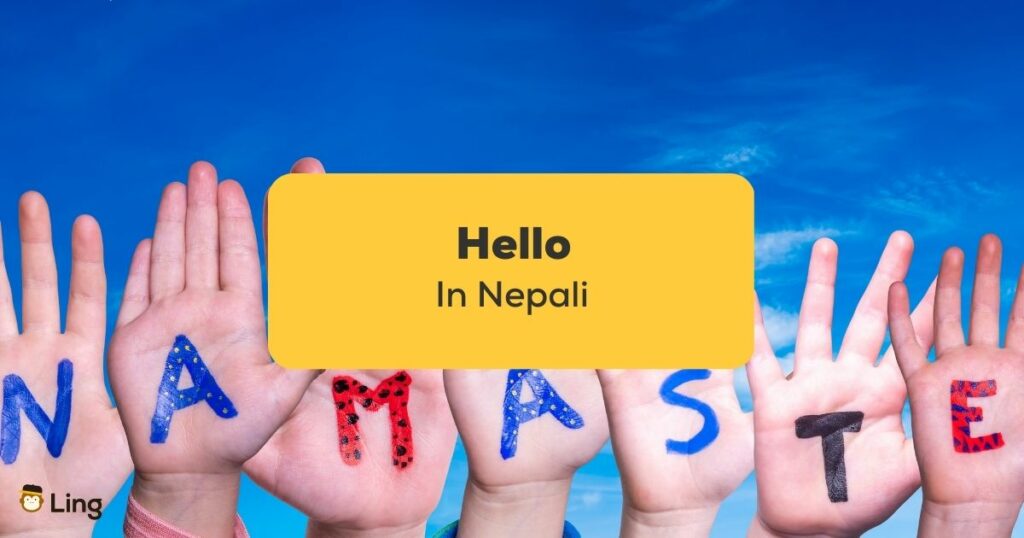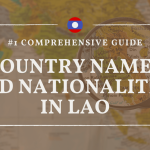Nepal is a small but beautiful country in South Asia, known for its mountainous landscapes and rich cultural heritage. If you want to enjoy your stay more, it will be a great idea to know how to say नमस्कार (pronounced as Namaskāra) or hello in Nepali.
In today’s post, we’ll walk you through the best way and most interesting ways to say hello in Nepali like a native speaker. Ready to learn more about Nepali words? Let’s start!
6 Amazing Ways To Say Hello In Nepali
In Nepali, there are a few ways to say “hello.” Usually, it is “Namaskar” (नमस्कार). Other basic words include:
- Namaste (नमस्ते) – This is a formal way to greet someone and is commonly used in both personal and professional settings. It is equivalent to saying “Hello” or “Good morning/afternoon/evening” in English. It means, “I greet the god within you.”
- Sannu (सन्नु) – This is a casual way of saying “hello” and is often used among friends or family members. Generally, it is not used even for an older brother or older sister.
- Pranam (प्रणाम) – This is usually for someone older. It can be used at any time of the day or night and is similar to Namaste and Namaskar.
- Subha Prabhat (सुभ प्रभात) – This is a more formal way to greet someone in the morning and is equivalent to saying “Good morning.”
- Subha Sandhya (सुभ सन्द्य) – This is a more formal way to greet someone in the evening and is equivalent to saying “Good evening.”
- Salam (सलाम) – This is commonly used by Muslim people.
Keep in mind that these are just a few ways to say “hello” in Nepali, and regional variations may differ from the local language. Remember that the Eastern and Central dialects of the Nepali language are very different, especially slang and languages among peers.
What Is The Nepali Language?
Before we begin getting to know some basic words that reflect hello, let’s look at the language of Nepal a bit closer. Nepali is written in the Devanagari script, which is also used for several other regional languages, including Hindi and Sanskrit. The Nepali vocabulary is vibrant and is influenced by Pali, Prakrit, Apabhramsa, Urdu, Bengali, English, and of course, Hindi and Sanskrit.
Nepali is a tonal language, meaning a word’s meaning can change depending on the pitch or tone used to pronounce it. For example, the term kukur (कुकुर) can mean either “dog” or “nail,” depending on the tone.
So, you might want to practice that! Nepali also has a special set of gender-based pronouns. For example, in addition to the standard pronouns (he, she, it), Nepali also has a bunch of pronouns for addressing elders of different genders.

Basic Phrases For Greeting Someone In Nepali
Now that you’ve picked up various ways to say hello in Nepali, you should also start a conversation with them. Practicing your speaking skills will help you memorize important and common Nepali vocabulary words. Here are some basic phrases that are worth noting.

Tips On Saying Hello In Nepali
Even though Nepali may not be your native language, it is good to know more about Nepalese culture.
In Nepal, head movements are not typically used to say hello. Common greetings such as namaste, sannu, subha prabhat, and subha sandhya, as well as salam, are usually accompanied by a verbal greeting rather than a head movement.
However, it’s worth noting that nonverbal communication, such as body language, can play an essential role in social interactions in Nepal. For example, when greeting someone older or of higher social status, it’s common to make a slight bow or gesture of respect. Similarly, a hug or a handshake may be appropriate when greeting someone who is a close friend or family member.
Also, in some parts of Nepal, particularly in the Terai region, people use a slight head nod as a way of greeting. It’s a quick and informal way of acknowledging the other person’s presence, similar to saying “hi” or “hey” in English.
As Nepal is a diverse country with various cultural practices, you might find different forms of greetings based on region, religion, and ethnic groups. And it’s always good to learn and adapt to the local customs.
Learn Nepali With The Ling App
Various resources and methods are available for learning a new language, such as language classes, language schools, tutors, language exchange programs, and language learning apps and websites. Some of these resources might better suit certain people or learning styles than others.
The Ling app is a popular choice among language learners as it covers a variety of languages and provides detailed lessons, interactive exercises, and quizzes which will help the learner to be engaged and make the learning process more interactive, practical, and fun. It also includes the feature of speech recognition which will help the learner improve speaking.
Suppose you’re interested in an online resource to learn Nepali. In that case, it’s important to find one that offers a variety of materials, such as quality audio recordings, basics on vocabulary lists, and beginning interactive exercises, as well as resources that allow you to practice speaking and listening to know how words are pronounced.
It’s time to stop the worry wagon! Choose the Ling app by downloading it from the Play Store or App Store. Trust us; you will be talking in Nepali, and ready to visit Nepal in no time!



































































